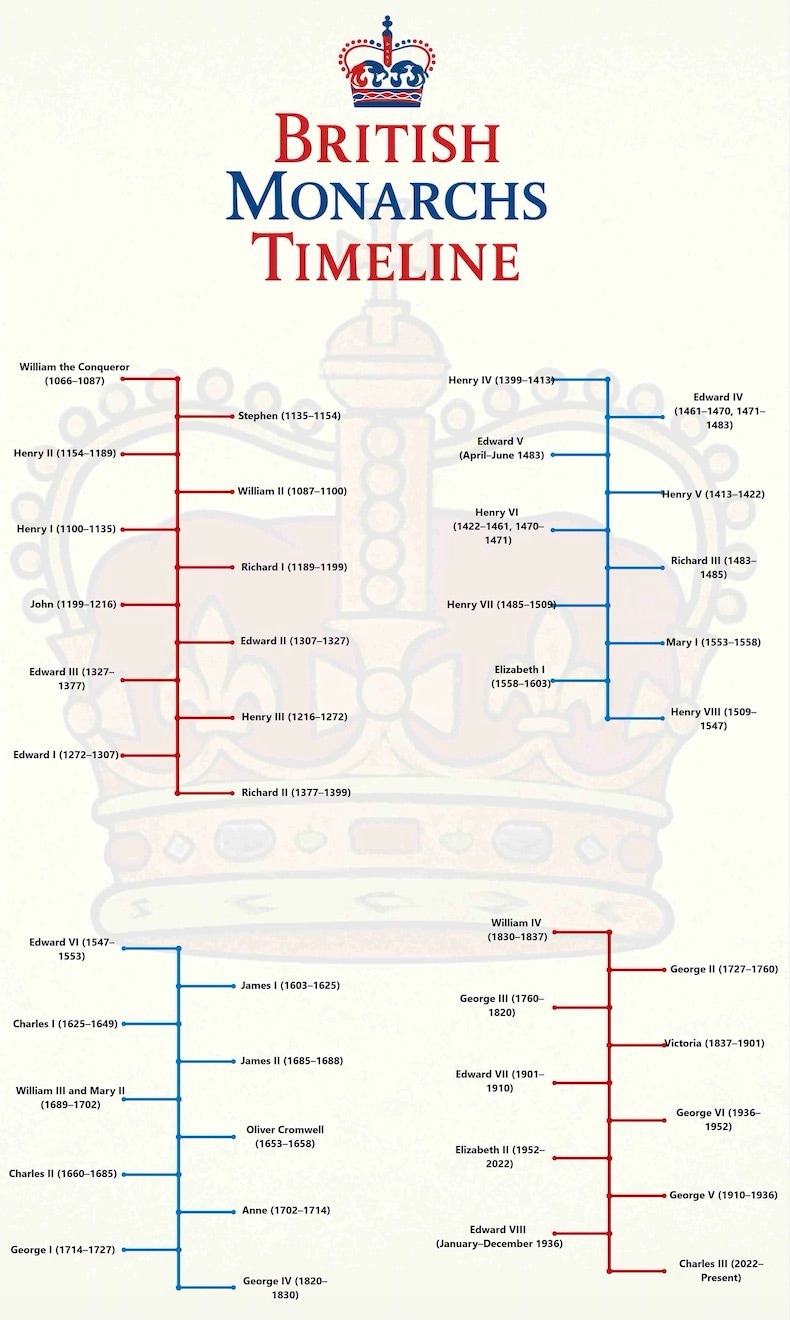The United Kingdom has had kings and queens for almost a thousand years. But today, the monarch is more of a symbol. They are the head of state, not the one running the country. Real power rests with the prime minister and the government. That’s what we call a constitutional monarchy.
Over the centuries, there have been more than 60 monarchs. Some ruled for decades, like Elizabeth II with 70 years on the throne. Others, like Edward VIII, lasted less than a year.
Let’s go back in time and meet each ruler, from William the Conqueror all the way to Charles III. We’ll see what they did, how they ruled, and what kind of legacy they left behind.
In this article
British Monarchs Timeline
Battles. Crowns. Scandals. The British monarchy has seen it all. From William the Conqueror to Charles III, every ruler left their mark. Some for glory, others for chaos. The monarchy may look symbolic today, but its history is packed with power, drama, and change. This timeline takes you through it all. So, let's get started!
William the Conqueror (1066-1087)
Everything changed in 1066 when William, the Duke of Normandy, fought King Harold at Hastings and won. He became king of England and brought many French customs with him. William also made a big survey called the Domesday Book and built strong stone castles. In doing all this, he changed England forever.
William II (1087-1100)
William II, called William Rufus, became king after his father. He was bold, quick-tempered, and sometimes cruel. His reign had a lot of tension, especially with the church and nobles. In 1100, he died suddenly when an arrow hit him while hunting. Was it an accident or a plot? No one knows. Either way, his younger brother Henry became king soon after.
Henry I (1100-1135)
Henry I moved fast after William II’s death. Known for being clever and practical, he worked hard to strengthen England’s government. He also married strategically to secure alliances. But tragedy hit when his only son drowned at sea. With no male heir, England became unstable, teetering on the edge of civil war.
Stephen (1135-1154)
Stephen wasn’t the obvious choice for king, but he grabbed the crown anyway. His cousin Matilda wasn’t happy, and their rivalry sparked a civil war called “The Anarchy.” Loyalties changed constantly, and the country faced chaos. Eventually, peace came when Stephen agreed that Matilda’s son would inherit the throne, ending years of fighting.
Henry II (1154-1189)
Henry II, founder of the Plantagenet dynasty, restored royal authority and reformed law. Intelligent and ambitious, his reign brought progress but also turmoil. His conflict with Archbishop Thomas Becket led to Becket’s shocking murder, reflecting Henry’s troubled legacy.
Richard I (1189-1199)
Richard the Lionheart was a true warrior king. His life was full of battles and crusades, and he spent very little time in England. He nearly bankrupted the crown with his military campaigns, but his courage made him a legendary figure. Richard died in France, fighting in battle, leaving behind a story of bravery and adventure.
John (1199-1216)
King John, Richard’s brother, was deeply unpopular. He lost valuable lands in France, raised taxes, and angered his nobles. In 1215, the barons forced him to accept the Magna Carta, limiting royal power. John hated it, yet the charter shaped England’s future government forever.
Henry III (1216-1272)
Henry III became king at just nine years old. He loved art, religion, and architecture but lacked political strength. Rebellions arose during his long reign, and Parliament gained more influence. Despite trying hard, he often struggled to maintain control, leaving a mixed legacy.
Edward I (1272-1307)
Edward I was determined and strong. He conquered Wales and challenged Scotland, earning the nickname “Hammer of the Scots.” He also reformed laws and strengthened Parliament. Edward was a builder, a warrior, and a reformer, leaving a lasting mark on England’s history.
Edward II (1307-1327)
Edward II never lived up to his father’s reputation. He relied too much on favorites, which angered the nobles and even his wife, Queen Isabella. Eventually, she and her ally forced him to give up the throne. Edward died in prison under mysterious circumstances, leaving behind a cautionary tale about poor leadership and personal favoritism.
Edward III (1327-1377)
Edward III helped England recover after his father’s troubled reign. He started the Hundred Years’ War against France, won battles, and brought pride to the country. His reign saw great victories but also tragedies like the Black Death. He ruled fifty years, yet tensions grew behind the scenes, leading to chaos.
Richard II (1377-1399)
Richard II became king as a child, inheriting a kingdom still recovering from plague and war. As he grew, he became controlling and imposed heavy taxes, which angered nobles. Rebellion rose, and eventually his cousin Henry Bolingbroke challenged him. Richard lost the throne and likely died in prison. His fall marked the end of one dynasty and the rise of another.
Henry IV (1399-1413)
Henry IV wasn’t born to be king, but he claimed the crown after deposing Richard II. He faced constant rebellion, sickness, and doubts about his right to rule. Still, he managed to hold the throne and set the stage for his son Henry V, laying the foundation for a strong Lancastrian dynasty.
Henry V (1413-1422)
Henry V became a hero through his military victories, especially at the Battle of Agincourt in France. He was a bold, confident leader, and his short reign left a huge mark on English history. Sadly, he died young at 35, leaving the throne to his infant son Henry VI.
Henry VI (1422-1461, 1470-1471)
Henry VI became king as a baby, which made him vulnerable from the start. Gentle and kind, he wasn’t suited to handle the demands of ruling. His mental health struggles weakened the kingdom, leading to the Wars of the Roses. It was a long series of battles between the Lancastrians and Yorkists. Henry was deposed, restored, and eventually killed, leaving behind a tragic legacy.
Edward IV (1461-1470, 1471-1483)
Edward IV was confident, handsome, and a Yorkist to the core. He took the crown by force, lost it, and then regained it. His reign brought temporary peace, but after his death, his sons disappeared under mysterious circumstances, probably murdered. Edward’s time on the throne was full of intrigue, but he left England calmer than during the wars.
Edward V (April-June 1483)
Edward V never truly ruled. At just 12 years old, he and his brother were taken to the Tower of London and never seen again. Many suspect their uncle Richard, who became Richard III. Edward’s reign lasted barely two months, a sad story of ambition and ruthless politics.
Richard III (1483-1485)
Richard III took the crown during a time of suspicion and fear. He tried to protect his throne but was always in conflict with those around him. He died in battle at Bosworth Field, marking the end of the Plantagenet dynasty and opening the door for the Tudor family.
Henry VII (1485-1509)
After years of civil war, Henry VII brought peace by marrying Elizabeth of York, uniting the warring houses of Lancaster and York. He strengthened finances, controlled the nobles, and founded the Tudor dynasty. Henry wasn’t flashy, but his careful rule laid the groundwork for a golden age.
Henry VIII (1509-1547)
Henry VIII was larger than life. He changed England forever by breaking from the Catholic Church, making himself head of the Church of England, and marrying six times. He loved music, jousts, and power. By the time he died, England had a new religious identity, daughters to continue the crown, and a monarchy transformed.
Edward VI (1547-1553)
Edward VI became king as a young boy. He pushed Protestant reforms strongly, but because he was so young, others ruled in his name. Churches changed, Latin disappeared from services, and England looked very different. He died at just 15, leaving the throne open to new struggles.
Mary I (1553-1558)
Mary I wanted to restore Catholicism in England. She married Philip of Spain and punished those who resisted her faith, earning the nickname “Bloody Mary.” Sadly, she died without an heir and lost Calais, marking a tragic, fiery chapter in Tudor history.
Elizabeth I (1558-1603)
Elizabeth I, the famous Gloriana, ruled alone and with remarkable skill. She survived plots, defeated the Spanish Armada, and never married. Her reign saw Shakespeare, exploration, and a swell of national pride. She was the last Tudor, but one of the greatest, leaving a legend that still inspires today.
James I (1603-1625)
James I was the first Stuart king, ruling both England and Scotland. He survived the Gunpowder Plot and commissioned the King James Bible. He believed in the divine right of kings, clashed with Parliament, and loved learning. His reign was mostly peaceful, though tensions simmered beneath the surface.
Charles I (1625-1649)
Charles I wouldn’t compromise. He believed kings answered only to God, dissolved Parliament, and taxed on his own. This led to civil war. Eventually, Charles was tried and executed. It was a shocking event that shook the monarchy and left Britain searching for balance.
Oliver Cromwell (1653-1658)
Cromwell was not a king, but he ruled like one. After the Civil War, he led Parliament’s army to victory and had Charles I executed. As Lord Protector, he banned entertainment and crushed rebellions, shocking royalists. Strict and serious, he died before the monarchy quickly returned.
Charles II (1660-1685)
Charles II, called the Merry Monarch, returned from exile full of charm and humor. He reopened theaters and led England through plague, fire, and tricky politics with Parliament and France. Despite mistresses and careful schemes, the country stayed stable. He left no heir, but the monarchy endured.
James II (1685-1688)
James II tried to push too hard. As a Catholic king in a Protestant country, he tried to enforce his religion and angered Parliament. His daughter Mary and her husband William took over in the Glorious Revolution. James escaped, and kings now ruled with, not over, Parliament.
William III and Mary II (1689-1702)
A rare joint rule! William and Mary accepted Parliament’s power, signed the Bill of Rights, and defended England from threats abroad. Mary died early, leaving William to rule alone. Together, they established a lasting Protestant succession and cemented Parliament’s role in the monarchy.
Anne (1702-1714)
The last Stuart queen, Anne, oversaw the union of England and Scotland into Great Britain. Her reign included wars abroad and shifting politics at home. Despite many pregnancies, she had no surviving heirs. She loved her friends and despised political intrigue. Her death brought a German cousin to the throne, starting the Hanoverian line.
George I (1714-1727)
George I barely spoke English and preferred to live in Hanover, his German homeland. He allowed Parliament to run the country, which helped the first Prime Minister rise. George faced scandal and wasn’t widely loved, but the monarchy survived. Power was moving, kings would now rule less and symbolize more.
George II (1727-1760)
George II witnessed wars abroad, Handel’s music rise, and Jacobite rebellions. He argued with his son but left ministers to govern much of the country. As the last king born outside England, he strengthened the monarchy’s role. During his reign, Britain grew, and parliamentary governance became firmly established.
George III (1760-1820)
George III tried to be a good king. He ruled during turbulent times, lost the American colonies, and struggled with mental health. He loved farming and tradition, fought wars with France, and saw Parliament grow bolder. By the end of his long reign, the monarchy had become more symbolic than powerful. George spent his later years in a quiet retreat.
George IV (1820-1830)
George IV, once a regent, loved luxury and style. He built the Royal Pavilion at Brighton and enjoyed a lavish lifestyle. His reign was marked by personal scandal, health problems, and a failed marriage. People mocked him, and Parliament limited his power. Still, he left his mark through architecture and culture, even if his rule wasn’t politically strong.
William IV (1830-1837)
The Sailor King had a short but meaningful reign. He oversaw the Reform Act, which expanded voting rights and changed politics. William preferred simplicity and disliked pomp. Though he had no heirs, his steady hand guided the monarchy through a transition before passing the crown to his niece, Victoria.
Victoria (1837-1901)
Queen Victoria became a symbol of an empire at its height. She ruled through industrial growth, empire expansion, and personal sorrow after losing Prince Albert. She oversaw a nation that grew powerful and influential worldwide. Victoria commanded respect, defining an era that changed the world forever.
Edward VII (1901-1910)
Edward VII finally got the crown after waiting decades. Charming, worldly, and skilled in diplomacy, he modernized the monarchy and strengthened Britain’s role in Europe. His short reign mixed style, travel, and politics. While the sun still shone on the empire, the clouds of the First World War were already gathering on the horizon.
George V (1910-1936)
George V was defined by duty. He guided Britain through World War I, changed royal titles from German to British, and faced a Europe in revolution. He kept the monarchy steady, helped modernize its image, and passed the crown to the next generation under growing pressures and public attention.
Edward VIII (1936)
Edward VIII loved Wallis Simpson more than the crown. He abdicated to marry her, which Britain could not accept. His reign lasted less than a year. Tradition cracked, and his brother became king. Edward lived mostly in exile as the Duke of Windsor. His story is both love and duty colliding.
George VI (1936-1952)
George VI wasn’t expected to be king, but he stepped up after Edward’s abdication. He led Britain through World War II with calm courage. He struggled with a stammer but never wavered. The empire began to change and modernize under his reign. He died relatively young, leaving the throne to his daughter.
Elizabeth II (1952-2022)
Elizabeth II became queen at 25. She ruled through decades of wars, social change, and cultural shifts. She stayed calm, steady, and dependable throughout it all. Her seventy-year reign became a modern Elizabethan age. She witnessed history firsthand and showed how the monarchy could adapt while keeping tradition alive.
Charles III (2022-Present)
Charles III became king after decades of waiting and public scrutiny. He now rules in a world very different from his mother’s early reign. Climate change, cultural diversity, and political challenges define his time. He blends tradition with activism, beginning his chapter with hope, responsibility, and a vision for the future of Britain.
How to Make the British Monarchs Timeline in EdrawMax?
The history of the British monarchy is complicated. But your timeline shouldn't be. With EdrawMax, a wonderful timeline creator, you can design a professional-looking monarchs timeline in just a few steps. Here's how you can create your British Monarchs timeline using EdrawMax:
Step1Start With a Blank Canvas
- Open EdrawMax on your desktop.
- Log in or sign up if you don’t already have an account.
- Click New on the left panel and select Blank Drawing to open a fresh canvas for your timeline.

Step2Insert a Background Image
- Go to Insert on the top toolbar and select Picture.
- Choose Local Pictures to upload a background image.
- Adjust brightness, contrast, or transparency in the Adjust panel to suit your design.
- Right-click, and select Move to Layer > Background to lock it, so it doesn't move.
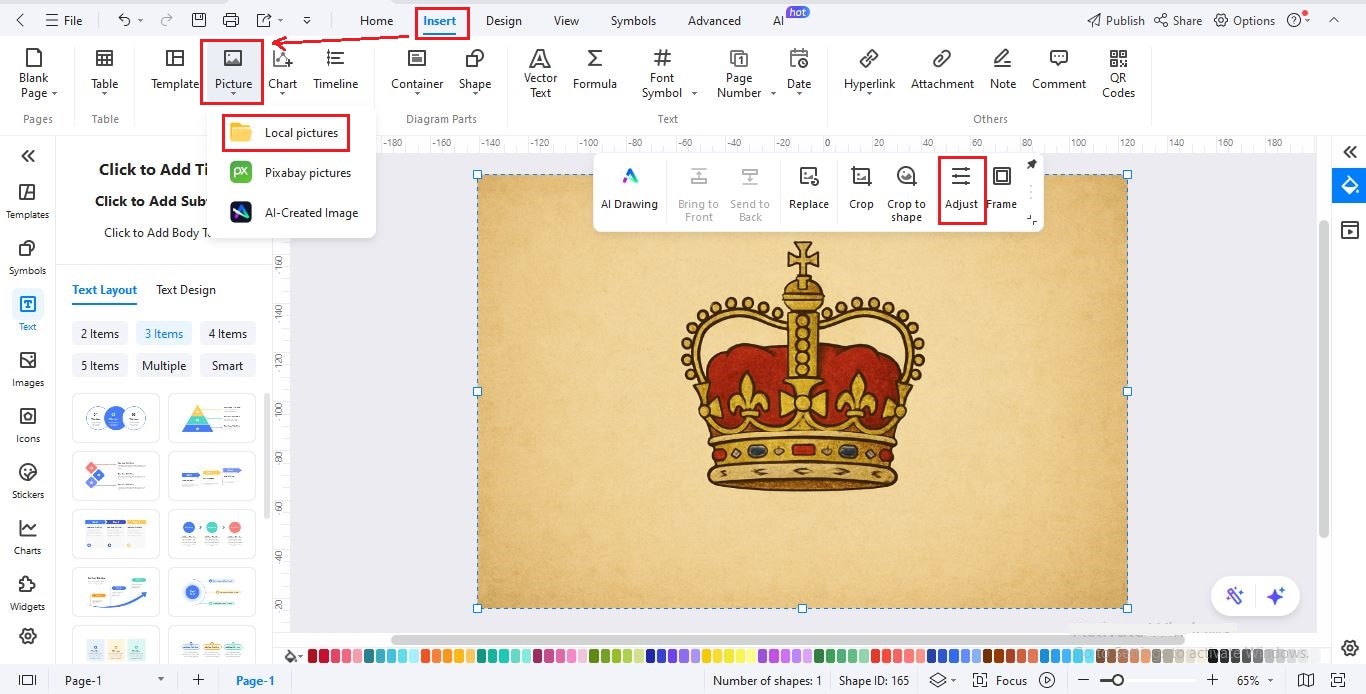
Step3Add a Heading
- Insert a heading using a text box or an image.
- Go to Insert > Picture > Local Pictures to upload a title banner like “British Monarchs Timeline”.
- You can also add an icon such as a crown or royal coat of arms.
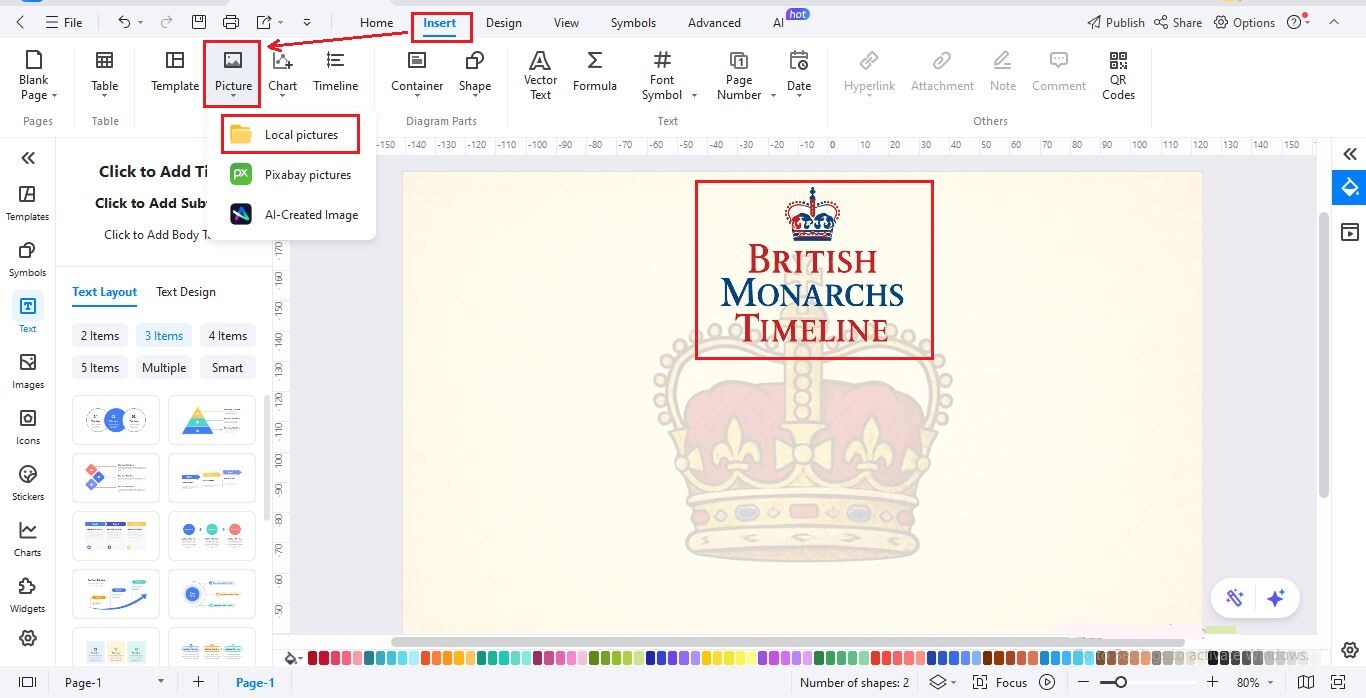
Step4Insert the Timeline
- Click Insert on the top toolbar.
- Select Timeline, scroll to Vertical Timeline, and pick a style that suits your needs.
- Click OK to add it to your canvas.
- Click the timeline, and a toolbar will appear to customize the timeline structure.
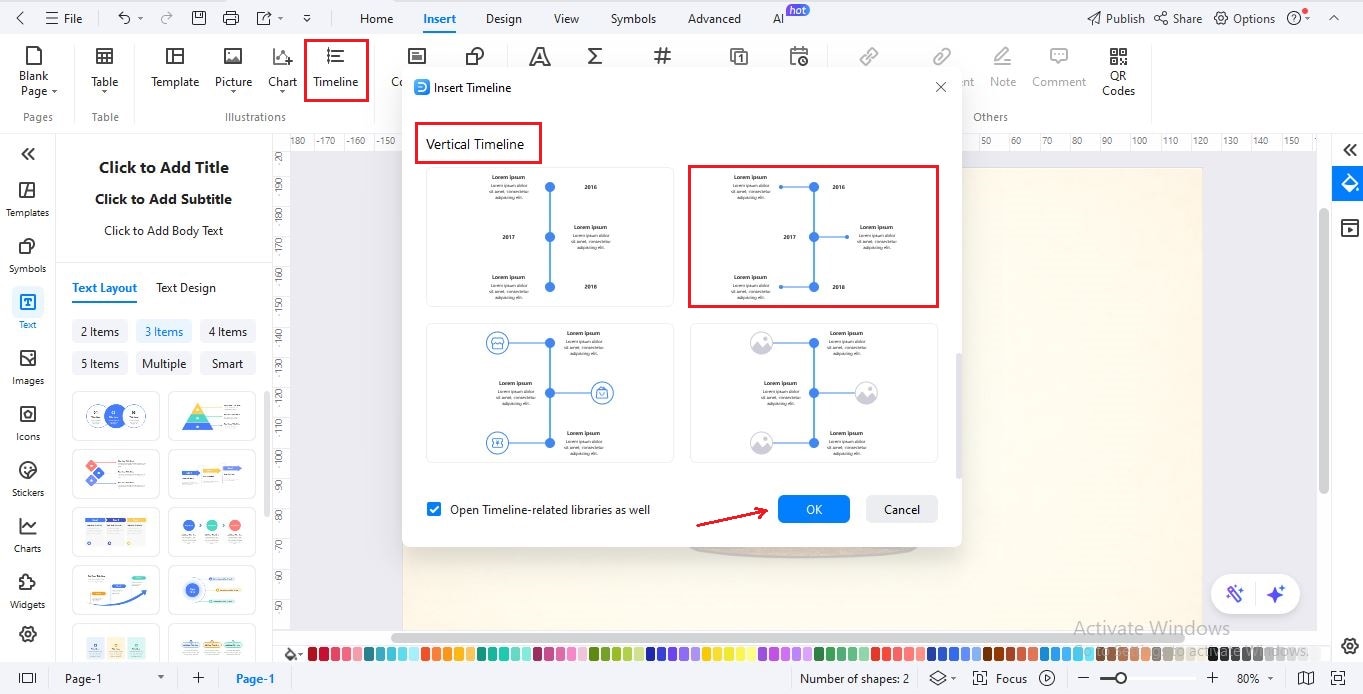
Step5Add Text to the Timeline
- Click Text on the left panel.
- Use Click to Add Subtitle to enter details about the monarchs.
- Continue adding monarchs in chronological order.
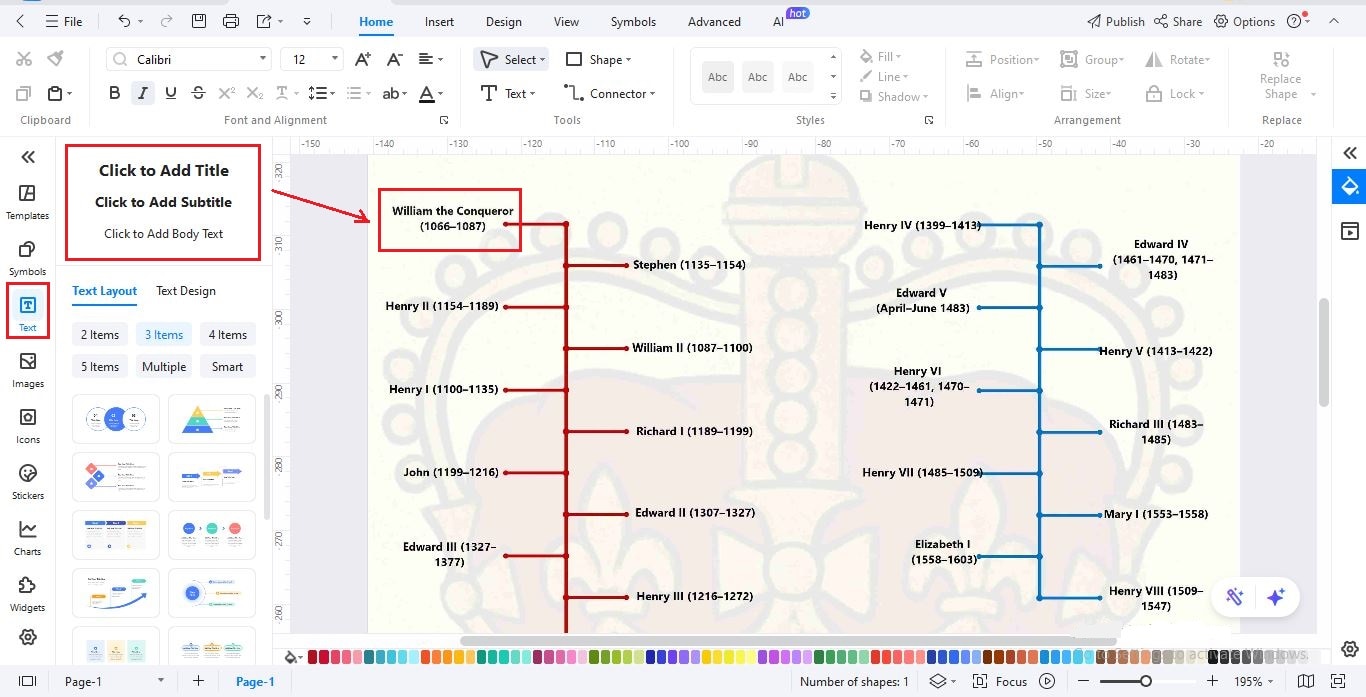
Step6Save, Share, or Export
- Click File > Save to keep an editable version of your timeline.
- Use Share to collaborate or present your work.
- To export, go to File > Export and select your preferred format (PNG, PDF, SVG, HTML, Visio, or Excel).
- Click Publish to share your timeline with the EdrawMax community.
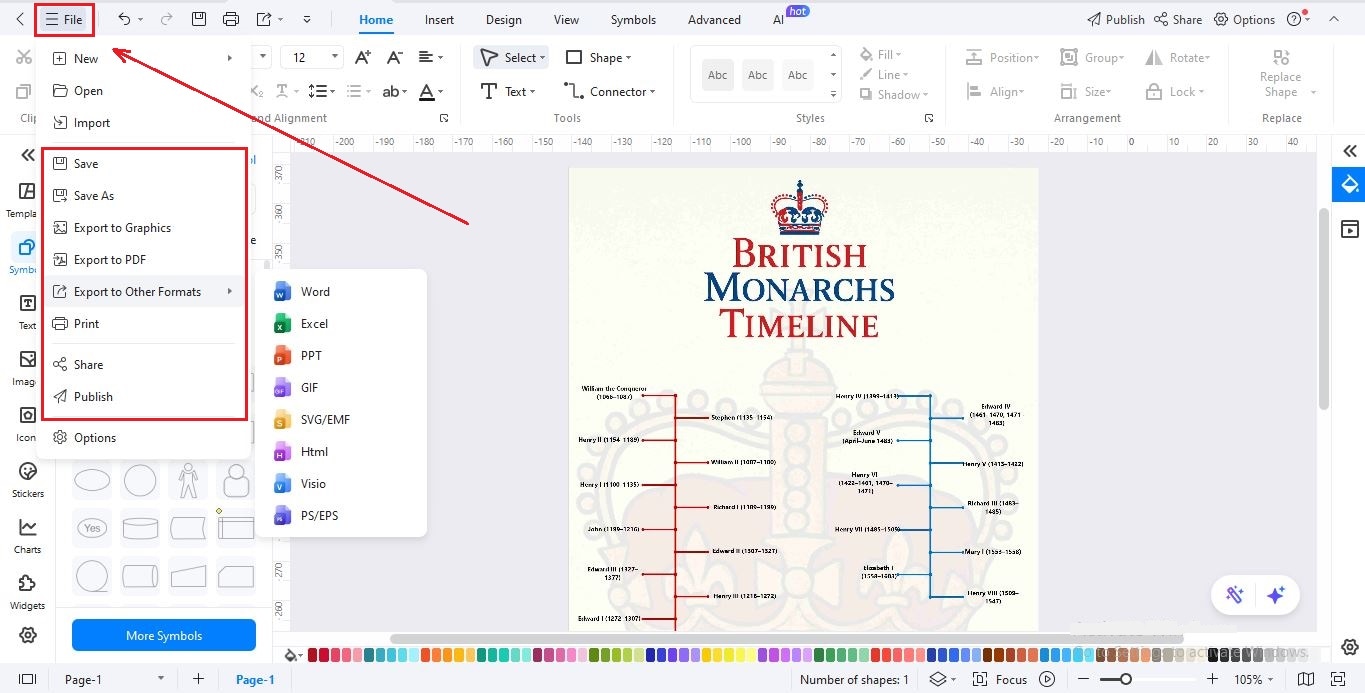
The Future of British Monarchy
The monarchy no longer governs, but it still holds cultural weight. As Britain changes, the crown must prove its relevance to younger generations. Its survival depends not on power, but on connection.
If you enjoy exploring history, why not visualize it yourself? With EdrawMax, you can transform complex stories like this into clear, engaging timelines.




